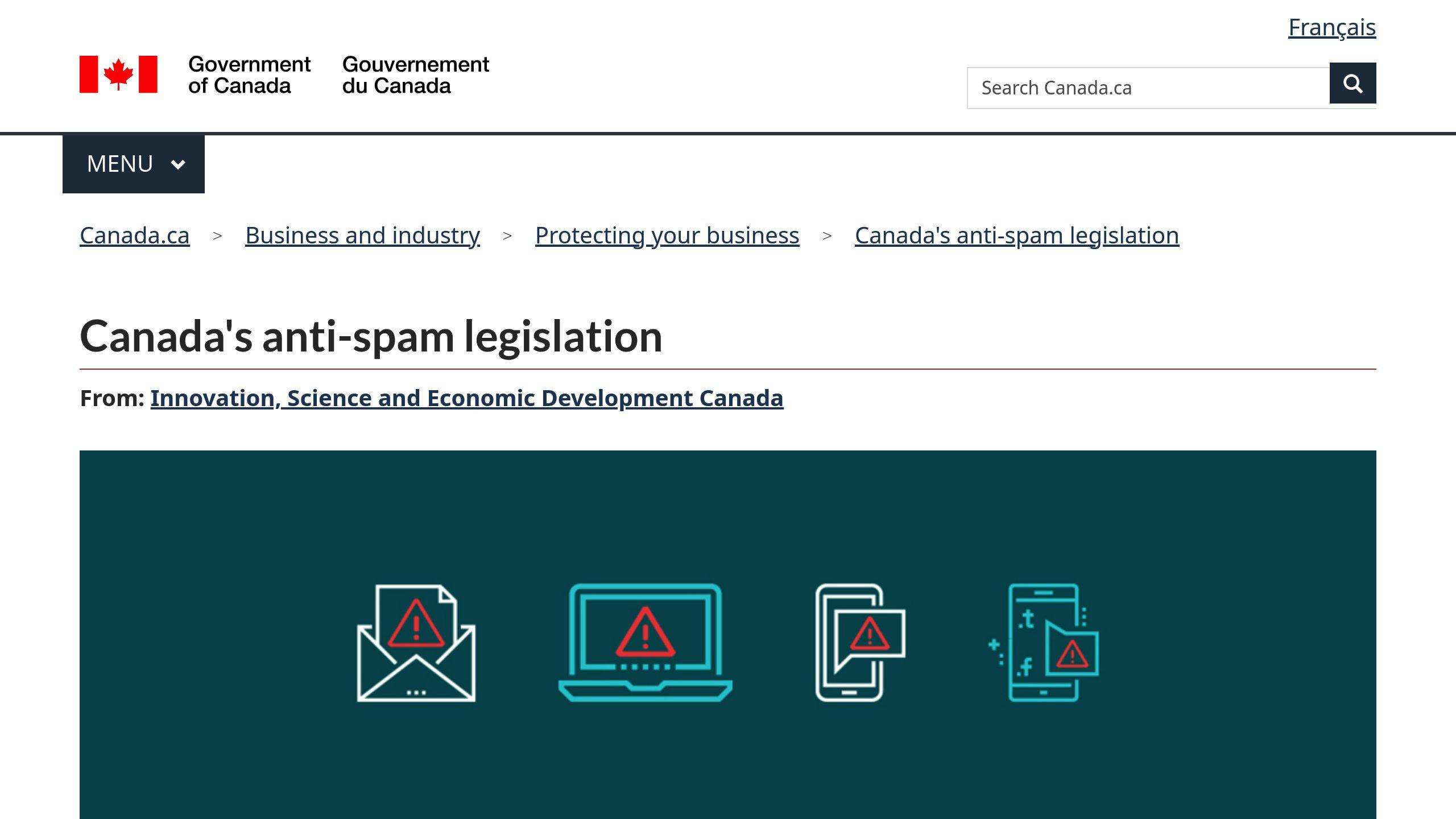Permission-based email lists are essential for effective and compliant email marketing. They consist of subscribers who explicitly opt-in to receive your emails, ensuring better engagement, legal compliance, and trust. Here's what you need to know:
- Why Permission Matters: Reduces spam complaints, aligns with laws like GDPR, CAN-SPAM, and CASL, and builds trust with your audience.
- Key Legal Requirements:
- GDPR: Explicit consent, data protection, and easy opt-out options.
- CAN-SPAM: Clear unsubscribe links, accurate subject lines, and a valid physical address.
- CASL: Obtain permission, identify the sender, and maintain functional unsubscribe options.
- Best Practices:
- Use double opt-in to confirm subscribers’ interest.
- Maintain list hygiene by removing inactive or invalid emails regularly.
- Provide clear and easy-to-use unsubscribe options.
Avoid shortcuts like buying email lists, as they harm engagement and risk legal penalties. Instead, focus on ethical growth strategies like opt-in forms, exclusive offers, and referral programs.
Quick Tip: A clean, permission-based email list improves deliverability, engagement, and sender reputation while keeping you compliant with global regulations.
Legal Frameworks for Permission-Based Email Lists
Understanding email marketing regulations is essential for businesses operating in different regions. Following these laws not only helps avoid hefty fines but also enhances your brand's reputation in today's privacy-focused world. Here’s a breakdown of the key legal frameworks governing permission-based email marketing in major markets.
CAN-SPAM Act (US)

The CAN-SPAM Act outlines strict rules for commercial emails in the United States. Penalties for violations can reach up to $43,280 per email [1]. Here’s what you need to know:
| Requirement | Description |
|---|---|
| Opt-Out Mechanism | Include a clear and easy-to-find unsubscribe link in every email. |
| Processing Time | Unsubscribe requests must be honored within 10 days. |
| Physical Address | A valid postal address must appear in all marketing emails. |
| Subject Lines | Subject lines must accurately represent the email content. |
GDPR (EU)
The General Data Protection Regulation (GDPR) is one of the most stringent data privacy laws globally.
"GDPR compliance builds trust and shows commitment to data protection."
Key requirements for email marketing under GDPR include:
- Explicit Consent: Subscribers must clearly opt-in without any ambiguity.
- Data Protection: Use proper security measures to safeguard subscriber data.
- Right to Withdraw: Make it easy for users to revoke their consent at any time.
- Documentation: Maintain records of when and how consent was obtained.
CASL (Canada)

Canada's Anti-Spam Legislation (CASL) enforces strict rules for sending commercial electronic messages. Non-compliance can lead to fines of up to $10 million for businesses [1].
| CASL Component | Requirement |
|---|---|
| Consent | Obtain clear permission before sending emails. |
| Identification | Clearly identify the sender and provide contact details. |
| Unsubscribe | Ensure unsubscribe options remain functional for at least 60 days. |
| Record Keeping | Keep detailed records of consent, including time and method. |
For example, GDPR violations have resulted in substantial fines, such as the £183 million penalty imposed on British Airways [5].
These regulations aren’t just about avoiding penalties - they encourage ethical marketing practices that build trust and long-term customer relationships. By understanding these frameworks, you can stay compliant while improving your email marketing strategies.
Best Practices for Building and Managing Permission-Based Email Lists
Creating a permission-based email list is just the beginning. To make it truly effective, you need to follow strategies that ensure compliance, keep subscribers engaged, and maintain long-term success.
Double Opt-In Process
Using a double opt-in process guarantees that your subscribers are genuinely interested and ensures compliance. This method requires users to confirm their subscription by clicking a link in a verification email. Here's how it works:
| Step | Action | Purpose |
|---|---|---|
| Sign-Up and Confirmation | User signs up and receives a verification email | Captures consent and validates ownership |
| Verification | User clicks the confirmation link | Confirms explicit consent and finalizes subscription |
Mailchimp reports that double opt-in lists see 45% higher open rates compared to single opt-in lists [1].
Building a strong list is only part of the equation. Keeping it in good shape over time is just as important.
Maintaining List Hygiene
To keep your email list effective and compliant, regular upkeep is essential. Here are some key tasks:
| Task | Frequency | Action Items |
|---|---|---|
| Remove Bounces | Immediately | Delete invalid addresses |
| Engagement Updates | Quarterly | Remove inactive subscribers and refresh contact details |
"Regular list cleaning can significantly improve deliverability rates and reduce the risk of being marked as spam" [3].
Staying on top of list hygiene helps you maintain high deliverability and avoid potential issues.
Clear Unsubscribe Options
Making it easy for subscribers to opt out builds trust and keeps your email practices compliant. Every email should include a visible, working unsubscribe link that processes requests within 10 days. To go a step further, offer a preference center where subscribers can:
- Adjust how often they receive emails
- Select specific content categories
- Pause communications temporarily
- Update their contact details
Keep an eye on unsubscribe rates as a key performance metric. If you see a sudden increase after a particular campaign, review the content and timing to identify what might have gone wrong [2].
sbb-itb-8abf799
Tools and Strategies for Growing Permission-Based Email Lists
Growing a permission-based email list requires a mix of ethical practices and the right tools. Below, we'll break down methods that comply with legal standards and help build a reliable email list.
Making Opt-In Forms Work
Opt-in forms are essential for growing your email list. They should grab attention without annoying users. Here's what makes an opt-in form effective:
| Element | Purpose | Best Practice |
|---|---|---|
| Value Proposition | Encourage sign-ups | Use a clear benefit statement |
| Form Fields | Collect essential data | Ask for minimal information |
| Call-to-Action | Drive conversions | Use clear, actionable buttons |
| Privacy Notice | Build trust | Include a privacy-compliant notice |
Place these forms in spots where users engage the most, like at the end of blog posts, on resource pages, in sidebars, or as exit-intent popups.
While opt-in forms are a solid starting point, advanced tools can take your email list growth to the next level.
Using AI Tools Like Email Extractor Tool

AI-powered tools, such as the Email Extractor Tool, can simplify the process of gathering emails from sources where users have given explicit consent. This Chrome extension automates email collection responsibly, helping save time while staying compliant:
| Feature | Benefit | Usage Guidelines |
|---|---|---|
| AI Automation | Speeds up email detection | Only collect from consented sources |
| CSV Export | Keeps data organized | Verify consent before adding emails |
| Volume Options | Scales with your needs | Choose a plan that fits your business |
Always ensure this tool is used responsibly, focusing only on sources where users have clearly opted in.
Why You Should Avoid Buying Lists
Purchasing email lists might seem like an easy shortcut, but it comes with serious downsides:
| Risk Factor | Impact | How to Avoid |
|---|---|---|
| Legal Violations | Potential penalties | Stick to organic list-building |
| Reputation Damage | Poor deliverability rates | Focus on permission-based growth |
| Poor Engagement | High bounce rates | Prioritize quality over quantity |
Instead of buying lists, focus on growing your audience organically by:
- Offering valuable content that encourages sign-ups
- Providing exclusive discounts or resources
- Building trust through social proof
- Running referral programs to attract new subscribers
Conclusion: Building a Compliant and Effective Email List
Creating and maintaining a permission-based email list means balancing growth with strict adherence to regulations and proven practices. By sticking to these principles, businesses can build email lists that not only meet legal requirements but also build strong connections with subscribers.
Here are three key areas to focus on:
| Pillar | Purpose |
|---|---|
| Legal Compliance | Following GDPR, CAN-SPAM, and CASL to avoid penalties and build trust |
| List Quality | Using double opt-in to boost engagement and minimize spam risks |
| List Maintenance | Regularly cleaning the list to improve deliverability and reputation |
"Maintaining a healthy email list by regularly cleaning out invalid, bounced, or unsubscribed addresses and ensuring explicit permission from contacts helps in reducing bounce rates and complaints. This improves sender reputation and inbox placement, leading to more effective email marketing" [1].
While compliance and quality are non-negotiable, using tools wisely can simplify the process and improve your list-building efforts. To keep your permission-based email list effective:
- Use double opt-in to confirm consent
- Be transparent about how you handle data
- Regularly clean your list to maintain engagement and deliverability
FAQs
Is double opt-in required for email marketing?
Double opt-in isn't mandatory in most places, but it’s a smart choice for ensuring compliance and boosting engagement. It confirms consent, cuts down on spam complaints, and provides a clear record of permission - especially useful for GDPR requirements.
"Double opt-in improves deliverability, engagement, and sender reputation." [4]
How to make emails GDPR compliant?
To meet GDPR standards, subscribers must actively give their consent. Here’s how you can ensure compliance:
Clear Consent and Transparency
- Keep detailed records of consent and preferences.
- Share clear privacy policies that explain how data will be used.
- Allow users to access or request deletion of their data.
Ongoing Maintenance
- Review your email list every six months to remove inactive or bounced addresses.
- Update subscriber preferences and consent records regularly.
- Stay on top of data protection laws to ensure compliance.
These steps help address common concerns marketers face when managing permission-based email campaigns. By following them, you can build a compliant and engaged email list.



